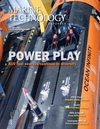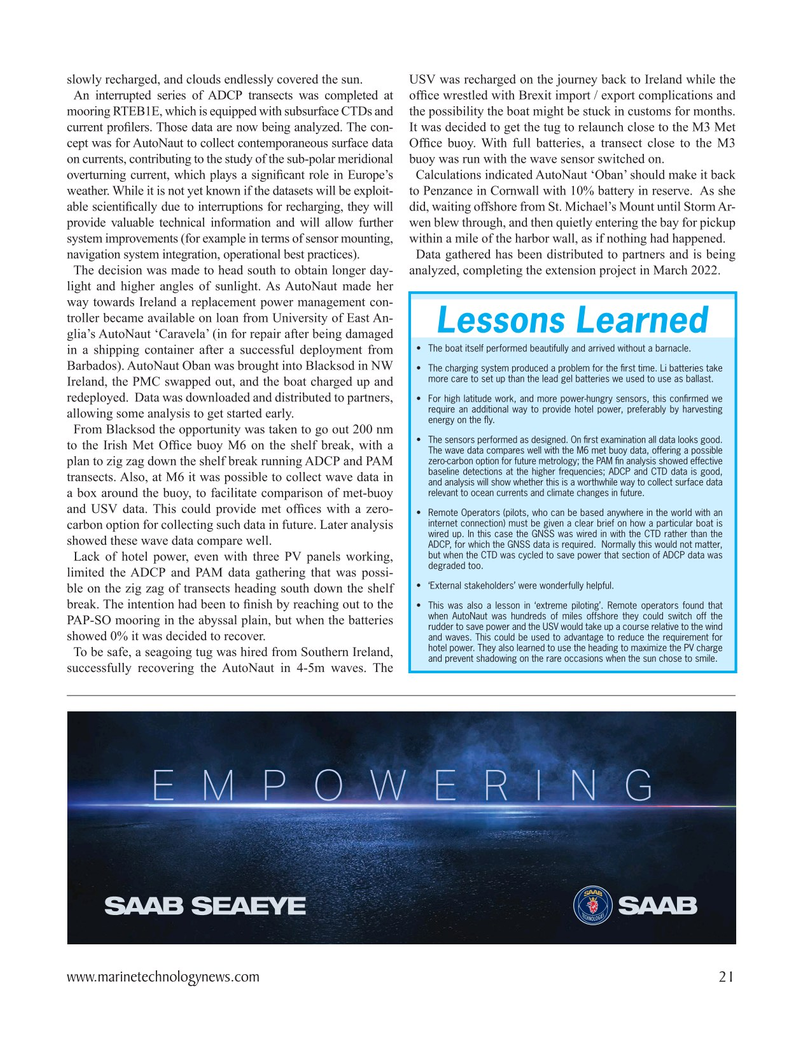
Page 21: of Marine Technology Magazine (July 2022)
Read this page in Pdf, Flash or Html5 edition of July 2022 Marine Technology Magazine
slowly recharged, and clouds endlessly covered the sun. USV was recharged on the journey back to Ireland while the
An interrupted series of ADCP transects was completed at of? ce wrestled with Brexit import / export complications and mooring RTEB1E, which is equipped with subsurface CTDs and the possibility the boat might be stuck in customs for months. current pro? lers. Those data are now being analyzed. The con- It was decided to get the tug to relaunch close to the M3 Met cept was for AutoNaut to collect contemporaneous surface data Of? ce buoy. With full batteries, a transect close to the M3 on currents, contributing to the study of the sub-polar meridional buoy was run with the wave sensor switched on. overturning current, which plays a signi? cant role in Europe’s Calculations indicated AutoNaut ‘Oban’ should make it back weather. While it is not yet known if the datasets will be exploit- to Penzance in Cornwall with 10% battery in reserve. As she able scienti? cally due to interruptions for recharging, they will did, waiting offshore from St. Michael’s Mount until Storm Ar- provide valuable technical information and will allow further wen blew through, and then quietly entering the bay for pickup system improvements (for example in terms of sensor mounting, within a mile of the harbor wall, as if nothing had happened. navigation system integration, operational best practices). Data gathered has been distributed to partners and is being
The decision was made to head south to obtain longer day- analyzed, completing the extension project in March 2022. light and higher angles of sunlight. As AutoNaut made her way towards Ireland a replacement power management con- troller became available on loan from University of East An-
Lessons Learned glia’s AutoNaut ‘Caravela’ (in for repair after being damaged • The boat itself performed beautifully and arrived without a barnacle.
in a shipping container after a successful deployment from
Barbados). AutoNaut Oban was brought into Blacksod in NW • The charging system produced a problem for the ? rst time. Li batteries take more care to set up than the lead gel batteries we used to use as ballast.
Ireland, the PMC swapped out, and the boat charged up and redeployed. Data was downloaded and distributed to partners, • For high latitude work, and more power-hungry sensors, this con? rmed we require an additional way to provide hotel power, preferably by harvesting allowing some analysis to get started early.
energy on the ? y.
From Blacksod the opportunity was taken to go out 200 nm • The sensors performed as designed. On ? rst examination all data looks good. to the Irish Met Of? ce buoy M6 on the shelf break, with a
The wave data compares well with the M6 met buoy data, offering a possible zero-carbon option for future metrology; the PAM ? n analysis showed effective plan to zig zag down the shelf break running ADCP and PAM baseline detections at the higher frequencies; ADCP and CTD data is good, transects. Also, at M6 it was possible to collect wave data in and analysis will show whether this is a worthwhile way to collect surface data relevant to ocean currents and climate changes in future. a box around the buoy, to facilitate comparison of met-buoy and USV data. This could provide met of? ces with a zero- • Remote Operators (pilots, who can be based anywhere in the world with an internet connection) must be given a clear brief on how a particular boat is carbon option for collecting such data in future. Later analysis wired up. In this case the GNSS was wired in with the CTD rather than the showed these wave data compare well.
ADCP, for which the GNSS data is required. Normally this would not matter, but when the CTD was cycled to save power that section of ADCP data was
Lack of hotel power, even with three PV panels working, degraded too.
limited the ADCP and PAM data gathering that was possi- • ‘External stakeholders’ were wonderfully helpful.
ble on the zig zag of transects heading south down the shelf break. The intention had been to ? nish by reaching out to the • This was also a lesson in ‘extreme piloting’. Remote operators found that when AutoNaut was hundreds of miles offshore they could switch off the
PAP-SO mooring in the abyssal plain, but when the batteries rudder to save power and the USV would take up a course relative to the wind showed 0% it was decided to recover.
and waves. This could be used to advantage to reduce the requirement for hotel power. They also learned to use the heading to maximize the PV charge
To be safe, a seagoing tug was hired from Southern Ireland, and prevent shadowing on the rare occasions when the sun chose to smile.
successfully recovering the AutoNaut in 4-5m waves. The
EMPOWERING www.marinetechnologynews.com 21
MTR #5 (18-33).indd 21 6/30/2022 12:56:32 PM

 20
20

 22
22
